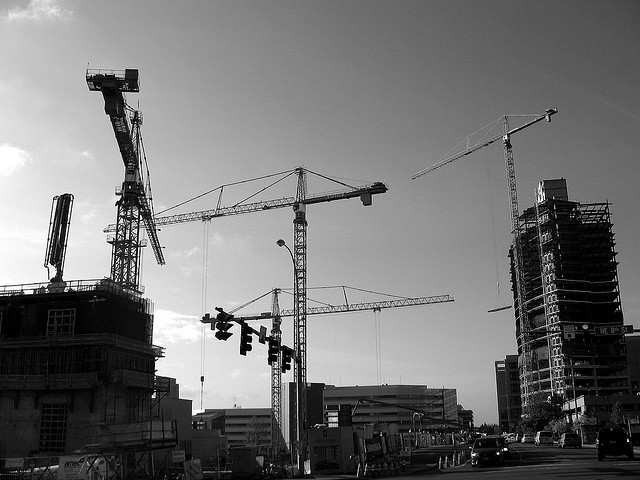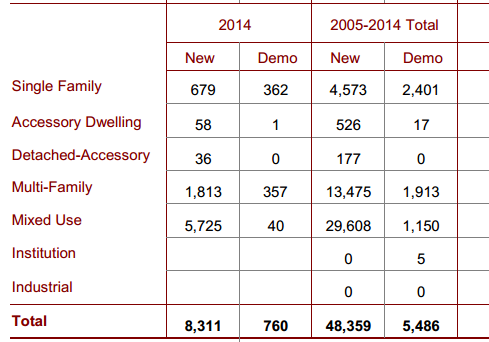
The City of Seattle released new construction data on January 15th and it shows a remarkable amount of new building. There were 8,311 housing units added in Seattle in 2014. Of those 7,538 were multi-family or mixed-use buildings. This means that over 90% of new housing units are mixed-use or multi-family. Single-family permitting accounted for the third most units, 679 but only about 8% of the total. The data also made it clear that Detached Accessory Dwelling Units and other Accessory Dwelling Units (DADUs and ADUs) are not popular, accounting for about 1% of all new units. This change is remarkable in a city that is 65% single family zoning.
During 2014 the city also permitted 760 demolitions. This means that the total additional housing added in 2014 is really only 7,551 units.

Putting the Numbers in Context
Most importantly though, we need to measure whether or not the city is successfully adding enough new housing. Over the last ten years the city averaged about 4,287 new units constructed per year. Initial planning in 2004 projected a need to accommodate 47,000 new households between 2004 and 2024. If 2010 average household size persists (which is unlikely since renters tend to have smaller household sizes and most new housing is rental housing), this translates to 4,841 new residents per year.
It turns out though that the most recent population growth numbers show the city of Seattle grew by 17,770 people in just one year. It is also obvious that the number of built units will exceed what the city projected. In ten years, the city produced 91% of twenty year projections.
Sustainable Housing Production
Seattle is exceeding expectations for both population growth and housing construction. Unfortunately, the latter isn’t keeping up with the former. The city appears to have a shortfall in additional housing units. To accommodate 17,770 people the city needed to build between 8,626 and 9,710 new housing units but only managed 7,551, missing demand by 10-22%.
The city is also undergoing a comprehensive plan update and will amend the projection for additional construction. Unfortunately, the most recent recommended update only adds 23,000 units to the projection, even though growth nearly doubled original expectations. A conservative estimate* would require 33,133 new units, 44% more than the proposed amendments. A high estimate** might require as many as 113,385 units.
There are a number of problems with Seattle’s housing market, including low vacancy rates at the bottom of the market, homelessness, displacement, boom and bust market cycles and housing quality. Solving those problems will require various solutions but it will definitely involve building enough housing for new residents. The city already has a shortfall in housing production and will need to produce more units in the future to make up for this shortfall. The city must be more realistic about growth.
*a conservative growth rate of 1% with a conservative household size of 2.06
**2.8% (the 2013-204 rate) and a smaller household size of 1.83 would require

Owen Pickford
Owen is a solutions engineer for a software company. He has an amateur interest in urban policy, focusing on housing. His primary mode is a bicycle but isn't ashamed of riding down the hill and taking the bus back up. Feel free to tweet at him: @pickovven.



